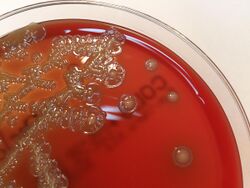Biology:Bergeyella zoohelcum
From HandWiki
Short description: Species of bacterium
| Bergeyella zoohelcum | |
|---|---|

| |
| Scientific classification | |
| Domain: | |
| Phylum: | |
| Class: | |
| Order: | |
| Family: | |
| Genus: | |
| Species: | B. zoohelcum
|
| Binomial name | |
| Bergeyella zoohelcum (Holmes et al. 1987) Vandamme et al. 1994[1]
| |
| Type strain | |
| ATCC 43767, CCUG 12568, CCUG 30535, CIP 103041[2] | |
| Synonyms | |
|
Weeksella zoohelcum[3] | |
Bergeyella zoohelcum is a Gram-negative, rod-shaped, aerobic and non-motile bacterium from the genus of Bergeyella which occurs in the upper respiratory tract of dogs and cats[1][2][4][5] Bergeyella zoohelcum can cause respiratory disease in cats.[4] Bergeyella zoohelcum can cause infections after dog bites.[6] [7][5][8]
References
- ↑ 1.0 1.1 Parte, A.C.. Bergeyella. https://lpsn.dsmz.de/genus/bergeyella.
- ↑ 2.0 2.1 Bergeyella zoohelcum. https://www.uniprot.org/taxonomy/1015#othernametable.
- ↑ Bergeyella zoohelcum. https://www.uniprot.org/taxonomy/1015.
- ↑ 4.0 4.1 George M., Garrity (2011). Bergey's manual of systematic bacteriology. (2nd ed.). New York: Springer Science + Business Media.. ISBN 978-0-387-68572-4.
- ↑ 5.0 5.1 Lin, Wei-Ru; Chen, Yao-Shen; Liu, Yung-Ching (2007). "Cellulitis and Bacteremia Caused by Bergeyella zoohelcum". Journal of the Formosan Medical Association 106 (7): 573–576. doi:10.1016/S0929-6646(07)60008-4. PMID 17660147.
- ↑ Chen, Yili; Liao, Kang; Ai, Lu; Guo, Penghao; Huang, Han; Wu, Zhongwen; Liu, Min (2017). "Bacteremia caused by Bergeyella zoohelcum in an infective endocarditis patient: case report and review of literature". BMC Infectious Diseases 17 (1): 271. doi:10.1186/s12879-017-2391-z. ISSN 1471-2334. PMID 28403835.
- ↑ (Hrsg.), G. Darai ... (2008). Lexikon der Infektionskrankheiten des Menschen : Erreger, Symptome, Diagnose, Therapie und Prophylaxe ; mit 33 Tabellen (3., überarb. Aufl. ed.). Berlin [u.a.]: Springer. ISBN 978-3-540-39005-3.
- ↑ Yi, Jumi; Humphries, Romney; Doerr, Laura; Jerris, Robert C.; Westblade, Lars F. (February 2016). "Bergeyella zoohelcum Associated with Abscess and Cellulitis After a Dog Bite". The Pediatric Infectious Disease Journal 35 (2): 214–216. doi:10.1097/INF.0000000000000971. PMID 26535880.
External links
Wikidata ☰ Q19930980 entry
| Wikimedia Commons has media related to Bergeyella zoohelcum. |
-->
 |

